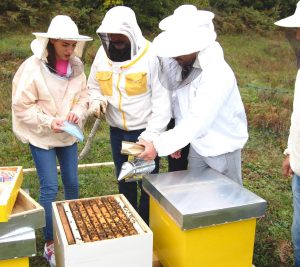Get ready: this column is about to contradict itself. Kind of. Our overall message each month (yawn) is meant to be that bees are a normal and important part of everyday urban living. Anyone who keeps bees for any length of time knows, however, that they change the keeper and they change the place in joyful and miraculous ways, and how can that be anything but cool? And it is cool for both bee and human.
In many ways, excessive hipness could be the downfall of urban beekeeping, especially on those Summer days when newbees have second thoughts while sampling melting drone larva, not an iced Americano. But you can approach looking amazing and ahead of the crowd in another way – by becoming a vibrant native part of a city which is totally cool in its essence, and attached to its very identity in place and time. It is looking at your urban home as a center of unlikely and inspiring bee sanctuaries, and making sure that people know they are there.
City beekeepers are more likely to need out apiaries anyway: year in, year out, in our downtown short courses the question that mentors get asked most frequently before, after, and on snack breaks is this: “Can you help me find a place to set up my hives?” Over the years, we have found many wonderful and unlikely places, but one of the hard-to-hear things I want to say sometimes is “Get out there and discover this wonderful place for yourself!” It is an inspiring and empowering thing to do, and it makes me even that much more grateful to the bees.
That’s because I never knew my city, Washington DC, like I do now – from the tops of rec centers and the South Lawn of the White House, the garage roof of a major cemetery and the back walkway of a monastery.
I’ve driven bees through embassy security, brought them up a Smithsonian elevator and wheeled them through the VIP floor of a five-star hotel. You can do this, too, and then all the people who use that hotel, goggle at the back fence of the Executive Mansion, hand out the specially labeled honey at the Annual Fundraiser or the G-20 Summit, or just comment in passing know that bees belong in important places as well as backyards.
Every city is cool – people wouldn’t put up with the expense and hassles if they weren’t. Metropolitan areas are centers of history and culture, museums and communities of faith and gardens – and stuff I have no clue about. These places have roofs, utility areas, parking structures, and sometimes ground level display areas where people can learn and see bees in action. I can’t share with you in words, how much fun it is to get out there and discover it all, and sometimes be given keys to the back door.
There are bees on the roof of Chicago’s City Hall – and they were there long before I knew Thing One about keeping bees – as well as Buckingham Palace, the Waldorf-Astoria in New York, and NPR Headquarters right here (again) in DC. And the people in these cities know they are there: the local news finds them newsworthy, the tour guides throw in an aside as they shepherd groups down the sidewalk, the co-workers watch for tweets from the beekeepers and announcements of a harvest.
But how easy is it to get from the crowd outside the fence –looking in – to the utility corridor that goes to the roof? Well, it depends.
It’s always easiest to just be invited, and that happens sometimes. The best way to be found is to actually join a local club, or a community with some sort of identity around beekeeping, which sometimes receives requests for bees. My most precious out-apiary came to me this way several years ago, but I am not seeing so much of this now. The ranks of urban beekeepers have grown enough that I think many good places have been approached. By people they already know.
These days, you mostly have to ask sites to consider the inclusion of an apiary, and your success is directly proportional to the length of your acquaintance with that site. Consider volunteering – a free way in the back door of museums, public gardens, parks and similar sites and building trust that gives you even more access.
Even if you are a familiar face, don’t be surprised if the first response is “No!” They may be used to you, but not the idea (yet). And don’t give up. We’ve had bees at the U.S. National Arboretum Washington Youth Garden since 2006, but I asked for the apiary for the first time more than a year before. When they said they weren’t up for bees in 2005, I asked them how they felt about beekeeper presentations (which were just fine). After a year of tons of fun with grade schoolers, our proposal for a three hive apiary was accepted and has flourished ever since.
It takes trust, and a sense that you are invested in their special place, too, sometimes. At Historic Congressional Cemetery, I’d participated in fundraising, greening, and celebration planning activities for years before I was a beekeeper, but I did not get my chance until one key (frightened) person left. So I asked again. We now have a teaching apiary with six to 10 beekeepers participating.
Think about communities in which you are involved, and your professional networks. While it’s OK to try cold calling the reception or public outreach office of a major site, remember these folks are not in the business of making, but explaining access rules. Instead, I try to find someplace I have worked/volunteered or where a close friend or colleague has ties. I am not afraid to go to LinkedIn, identify the staffer at a site who may be well placed, and poke around until I find that indirect connection. Troll through company press releases to find the person in charge of green-er priorities, and maybe reach out to companies that provide those LEED consultations. Those companies adore beekeeper presentations! And have a coherent proposal in mind, and make it detailed and professional in proportion to how new your contact is.
There are so many corners of your city where people are doing wonderful things and creating beautiful places, and your bees can be there, too. Though this may seem intimidating, I can tell you from experience that it is enlightening, energizing, and empowering. I feel absolutely wonderful about the place where I live now that I know more about it, as well as about the lives of the creatures I look after here. The people who run those sites will be proud of the help they are offering the bees, and their visitors will share greater hope for a greener future. You all need to get to know each other, and give these people a chance to know the bees, and pretty soon your home town will be a better place for all of you.
The White House Bees – Leading From the Nation’s Backyard
When Charlie Brandts brought the first colony of White House bees through security in 2009, guards used to handling the safety of the free world blanched. Thousands of student and dignitary visits later, those bees have made friends across the region and the world. Why does this matter to us? If a yard full of helicopters, teenagers, Prime Ministers, Portuguese Water Dogs, manicured landscaping, and an Easter Egg Roll can make room for 60,000 bees, what’s your landlord’s excuse?
But more seriously, right in DC’s suburbs, activists who worked successfully to protect beekeeping in nearby counties in Virginia and Maryland pointed at the brand-new apiary as an example of how bees can fit in almost anywhere. And safely. And with real affection.
The G-20 leaders happily received this downtown DC honey in 2009, and Americans petitioned for the White House Honey Ale recipe in 2012. In the summer of 2014, honey bee health received a policy spotlight when the President’s Memorandum on Pollinator Health became a multi-agency priority It is hard to deny that the colony in his back yard had put a bee in his ear.
Montreal Airport Bees – Hundreds of Thousands of Local Flights Daily
Aéroports de Montréal announced the June, 2014 arrival of five beehives managed by local beekeeping organization Miel Montréal with the headline, “300,000 New Workers at Montréal-Mirabel!” The hives are located on part of the brushy, open ground which is characteristic of many airport facilities, and in fact airports from Chicago to Hamburg have also established apiaries.
In its announcement, the airport authority directly connected the bees with community, culture, and the environment: “Conscious of the importance of preserving these pollinators to safeguard our culture and biodiversity, this project underscores the engagement of Aéroports de Montréal in preserving the environment, sustainable development, and reducing the environmental impact of its activities.”
Chicago City Hall Roof Apiary: 12 Years of Females at the Top
The Chicago Honey Coop started out in 2004 as a way to connect young people with economic opportunities through an urban beekeeping program. Founders Michael Thompson and Stephanie Arnett were already rooftop beekeepers at the time! The organization is now even more a community partnership that also emphasizes education, food access, and connection to nature in one of the world’s great cities: the home of the skyscraper.
CHC has more than 50 hives in Chicago, including apiaries on the roof of Chicago’s City Hall! Thompson, CHC’s Farm Manager, has kept bees in Chicago since 1974.
The presence of nearby plantings matters to all urban beekeepers, of course, but green roofs seems to really deliver big benefits. “Habitat was important on City Hall in 2012 due to a significant drought in May and June, rare for us. The prairie plants on the green roof were noticeably helpful during this period, especially for pollen. (Potentilla & Penstemon among others).” The 20,300 square-foot green roof was installed in 2001 as part of the Mayor’s Urban Heat Island Initiative, a program to address higher temperatures caused by heat trapped in pavement and buildings in dense urban environments. In 2010, the City Hall roof experienced a cumulative 100 degrees F reduction in heat (adding the differences in temperature over time) compared to surrounding areas.
Thompson and beekeeping partner Stephanie Arnett have looked after the hives at City Hall since they were installed in the Spring of 2003. They founded CHC shortly thereafter. The City Hall Apiary is one of the most famous in the country, and the prized honey harvested there is used by the city to promote it’s environmental activities and educate the public about urban agriculture in Chicago.
Buckingham Palace Bees: Their Own Urban Island
The Queen of England, like the President of the United States, has an apiary that was installed in 2009 on the grounds of her primary residence. But unlike the bees on the south lawn of 1600 Pennsylvania Avenue, they are not so easy to see. Nonetheless, if you ask about bees in London, this apiary (and probably the one at famous department store Fortnum & Mason) is the most likely to be mentioned.
The Buckingham Palace Apiary is located on an island at this Central London secured compound, and now consists of four hives tended by London beekeeper John Chapple and one of the Royal Gardeners. The island is basically wild, and is not otherwise visited. Like many other hives at high profile locations, the Buckingham Palace bees are there because people are concerned about the decline in pollinators, and are looking at creative ways to promote conservation. See for yourself at www.kcpt.org/highlights/meet-bees-buckingham-palace/
Toni Burnham keeps bees on rooftops in the Washington, DC area where she lives.









